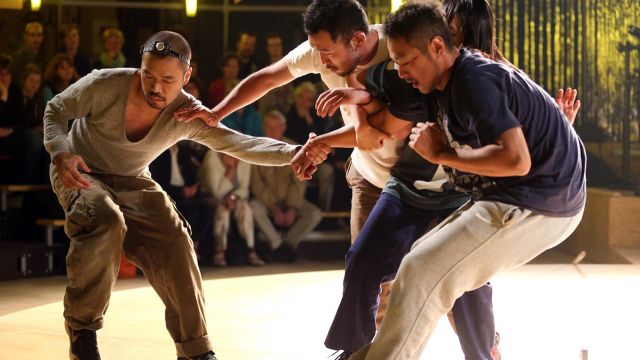Stuck in the Narrowest Path
One always wishes to support and acknowledge risk-taking and experimentation in theatre, but one must also be prepared to give honest feedback when a risky experiment fails to pay off.
In the case of this world premiere performance from Japanese improvisational-movement collective Contact Gonzo (founded in 2006), we witness its four members either simulating mysteriously motivated violence against each other, or else mystifying the audience with low-tech minimalist symbolism and apparent attempts at game-playing/world-building. These actions are accompanied by live strings from the Zephyr Quartet, as well as a constantly hovering sound recordist whose ultimate usefulness in the scheme of things remained elusive to the end.
On the positive side: this one-hour experience inadvertently provides an excellent opportunity for theatre buffs to gaze around at the inner workings of the Adelaide Festival Centre’s backstage and office areas. (As it turns out, all manner of starry cast photos, archival poster art, and amusing in-jokes can be found adorning the walls; one hopes to get the chance for a return visit, preferably with more time available to linger and take in all the rich history on offer.)
Also, the Zephyr Quartet’s contribution is commendable, and whoever made the decision to bring them on board deserves a great deal of credit. Beyond this admittedly meagre praise, however, it’s difficult to find much that would count towards a recommendation.
Proponents of this particular brand of physical theatre may well consider it to be the equivalent of a Rorschach test, a performance that is open to any and all manner of interpretations. Perhaps this really does mean that Stuck in the Narrowest Path is beyond any form of useful concrete analysis, being an inescapably subjective experience. If so, all that a reviewer can aspire towards is the ability to faithfully record their reaction and provide as much justification as possible for that reaction.
In this case, the most generous response this critic can offer is the acknowledgement that the Contact Gonzo team do, on occasion, in the early stages of this presentation, manage to momentarily confront their audience with the discomfort inherent in being made to witness strangers in the act of behaviour that is both unpredictable and anti-social. Ultimately, the lack of any real context, something that might have put the violence into some kind of useful perspective, is fatal for this performance.
The presentation here is ultimately a cyclical one, though not in a way that is very interesting, only aggravating (especially so in the case of pre-recorded vocal comments/commands that repeat themselves ad nauseam). With the show concluding in a virtually identical manner to how it begins, a numbing sense of emptiness and wasted time is all that this reviewer was left with. At the end of their hour, these performers have, sadly, failed to communicate anything of value, and neglected to provide a journey that was worth taking.
Anthony Vawser
Subscribe to our E-Newsletter, buy our latest print edition or find a Performing Arts book at Book Nook.

